

Travel log Kenia
Monday 25-09 (340 km)
At night I suffer from a severe bout of stomach disorder. And, for the first time during our trip, take a stronger medicine than Entosorbine. In the morning it is still not clear whether I can travel or not. Paul and the Manderveld family drive to Thika town to find an ATM and to fill all Wa Bashasha’s tanks. At 10.00 I am feeling slightly better and we decide to get on our way to Njoro, a small town some kilometres north of Nakuru. The road to Nakuru is the main road to Lake Victoria and the first 40 km we have nothing to complain about. Then this once so excellent road deteriorates rapidly and when we approach Naivasha we are crawling – together with the dense other traffic – over little islands of tarmac. Since we cannot make any speed at all, the petrol supply system packs up again and we have to put the car on the road shoulder and cool the petrol pump. Passing heavy lorries throw up tons of dust. Ten minutes later we are on the track again which, in our Kenya days in the 1970s, was the main road to the west. Time and time again, the petrol pump gives up and I have to make an effort not to panic. Luckily, we are compensated for our anxiety by the stunning views of the Rift Valley. When the sun gets lower, the silhouettes of the mountains show against purple and magenta skies. Some 30 km after Nakuru we discover that we have missed the turnoff towards Njoro and it takes some time until we have found the right junction. Half an hour later we pass the gate of Kembu Camp. We are too tired to get all the camping gear out and rent the only 4-bed cottage available and order dinner as well. Kembu Camp is part of Kenana farm, owned by the Nightingales. Already during our Kenya days, the Nightingale settler family was a legend and they are still there. The fifth generation raising cattle, breeding race horses and growing wheat and barley in these stunningly beautiful highlands. The cottage – overgrown with golden shower and honeysuckle – is a rustic little place and around 21.00 hours an excellent dinner is served by the female Kenyan staff. After dinner we sit in front of the log fire and sip our last South African wine.
Tuesday 26-09 (5 km)
Wa Bashasha day. The main reason why Paul wanted to stay in Njoro, was the fact that he had planned a main overhaul there for the old girl. In the Netherlands, he had heard about two guys – Toon Hanegraaf and Georg Theuri – who ran a garage and car rental service specialised in old Land Rovers: Roving Rovers Safaris. To our surprise we hear that the garage is only 500 metres away from the farm and campsite and at 08.00 hours sharp, we are there. At the garage we meet and discuss our wishes with him:
· Doing something about the failing petrol pump which has been harassing us for almost 4 months.
· Devising a construction that will save our front window frame and window panes to be crushed by the weight of the roof rack and roof tent.
· To stop the oil oozing from our freewheel hubs.
· To change all oils.
· To check the valve play and timing.
The failing petrol pump is no news to them. “All Series III 2.25l petrol engines have that problem in hot tropics combined with altitudes of 1500 metres or higher”. “Yes, the only remedy is to wrap a moist cloth around the fuel pump and drip cold water on it”. “But then, of course, we can also install an electrical back up fuel pump”. Paul does not believe what he is hearing. An electrical centrifugal fuel pump is to be installed in line with the present mechanical membrane pump. The electrical pump can be switched on from the dashboard as soon as the other pump begins failing. We decide to let them install one. If it works, Paul will sent the installation instructions to Jansen Land Rovers in Oisterwijk.
The front window issue is clear cut. The guys hardly believe that a roof rack supplier (Topsleeper in Vessem) was so irresponsible to let us travel through Africa without attaching the front of the roof rack to the bulkhead and chassis. We decide to let them carry out the welding operation. All the other things are routine. Later in the afternoon we check with the garage. The pump has already been fitted and they are looking for a 12V wire in the 24V system. Also the welding is on its way. Two mechanics are taking off all the wheels and are checking on the bearings, oil seals and brake linings and cylinders. It will, however, take them another full day to complete the car. Luckily we can extend our stay in our little caravan with one night.
Wednesday 27-09 (250 km)
Since Wa Bashasha is still in the garage, we hire a (30 year old!) Range Rover and drive to Lake Bogoria. The highlands and the Rift are beautiful and we enjoy the drive. Shortly before we enter the National Park, we see the Lake Bogoria Hotel signposted and decide to have lunch there. We all eat little because of upset stomachs, but at least we contribute something to the local economy.
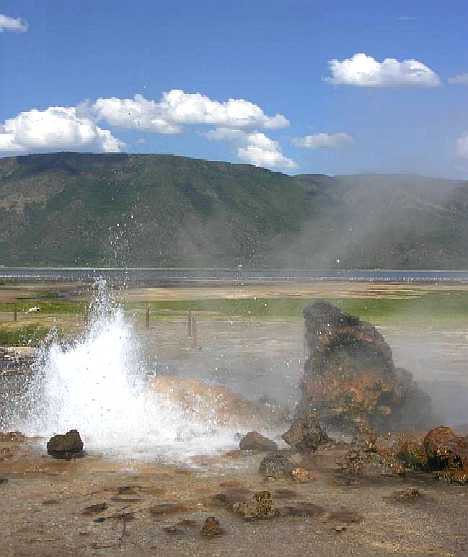
Lake Bogoria hot springs
The park wardens relieve us again of a considerable amount of US$ and we are again wondering whether Tanzania and Kenya are on the right way with their tourist industry. When you enter a park with 4 persons and a car, you pay anything from 100 to 200 US$. However, be aware! You either have tickets for the period from sunrise to sunset only or 24 hour tickets. Two nights in a park, therefore, cost you anywhere between 200 and 400 US$ entry fees. Campsite fees are not small either and may amount anywhere between 30 and 50 US$ per person. So, on average, for 4 persons and a 4x4 vehicle, be prepared to pay 460 US$ for 2 nights. For that money you have not eaten yet and forget about sipping a glass of whiskey! If you prefer a tented camp or banda you may easily pay 1000 US$ for two nights. If you go to the popular lodges, double that amount again. These rates are downright ridiculous and will keep tens of thousands of sensible tourists away from East African wildlife.
If a sizeable part of the revenues would go to wildlife conservation, upkeep of the parks and local communities near the parks, we would be less outspoken. There is, however, no sign of that. When we enter Lake Bogoria National Park, we find that the roads have not been maintained for decades, that the protective barriers around the hot springs have decayed and that the place is littered with plastic bags and empty bottles. The Arusha National Park in Tanzania was little better. Yet, Lake Bogoria is beautiful and we enjoy driving around!! It is already dark when we are back in Njoro.
Thursday 28-09 (60 km)
Although good progress is made on the car, she is not ready yet. We pick her up in the afternoon and drive to Nakuru to buy supplies, including a new 10 kg gas bottle. The roof rack supports indeed take a lot of weight of the windows and the new petrol pump runs at the flip of the switch. On our way back, however, and particularly up hill, the car does not accelerate enough and we drive her back to the garage. There, the people think that the new brake linings are gripping. Paul thinks that the timing is faulty and we decide to check out on the linings and the timing in the morning.
Friday 29-09 (310 km)
At 0.800 Paul is at the garage again. The brake linings are adjusted and when the timing mechanism is pulled from the motor block there is a lot of play in the shaft. A timing mechanism is cannibalised from another Series III and at 10.00 hours we are finally on our way to the Kakamega Rain Forest in Western Province. After some kilometres it is obvious that Wa Bashasha is not accelerating enough again, but luckily we discover soon that we are driving uphill with the roof tent fully unfolded!!! When we finally descend from the escarpment to the Lake Victoria Basin, it is obvious that Wa Bashasha has been cured of her ailments. Whenever the mechanical petrol pump becomes too hot, Paul flips the switch of the electrical pump and the fuel supply is immediately restored. The two welded metal supports have eliminated the metal on metal squeaks caused by the window frame rubbing on the bulkhead. Although our financial situation has deteriorated further by the repairs, we are happy. Some 40 km before we reach Kisumu, we turn to the right towards Chemelil, Nandi Hill and Kapsabet. The road is good to reasonable and the scenery stunning. Soon we climb up to 2000 metres again and call the guys at New De Brazza Kakamega Forest Camp. When we get hold of them, it appears that we are at the wrong end of the forest and have to make a loop first to get back to Kakamega town. At 17.30 hours we finally enter the camp and discover that it is under construction (to put it mildly).
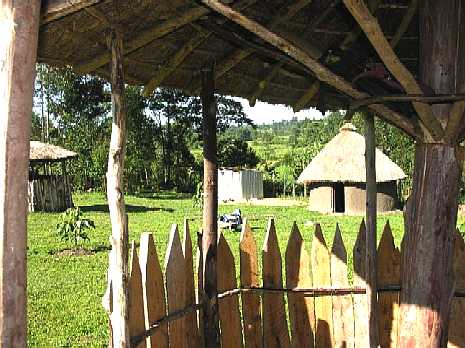
Kakamega New De Brazza Camp
A banda for cooking and a banda with two beds for sleeping. No running water, no showers and no light. At the back of the slightly sloping plot, there is a squatting toilet and a shed to wash. Huub and Eelko take the banda and we pitch up our roof tent for the first time since Mozambique. Next to the campsite, there is a small village and the villagers cook a good meal for us: chicken and chapattis. We sit around the smoking wood fire for a while and then turn in.
Saturday 30-09 (60 km)
Paul stays in the camp and we go for a short walking tour into the Kakamega Forest Reserve. That short walking tour - under guidance of Patrick - eventually lasts for almost six hours and by the time we are back in the camp, Paul is very worried, hopping mad and on the verge of driving to Kakamega to notify the police about the “missing” party.
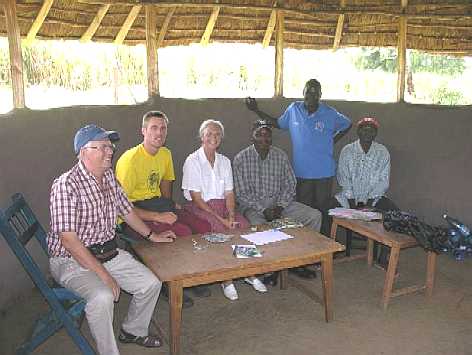
Cooking banda in Kakamega
After we have rested and after Paul has quietened down, he and Eelko, just before dark, drive to Kakamega to buy ingredients to make a strong pasta sauce (tomatoes, onions, garlic, ginger, pepper, salt and Worcestershire sauce). A cooking fire is lightened in the banda and we have Turkish macaroni with the sauce. There is enough for the two guards as well and we have a very pleasant evening chatting.
Sunday 01-10 (80 km)
Early in the morning there is some panic when a guy walks into the camp and asks me whether we are missing a mobile. As it turns out, Paul is missing his Iridium satellite phone. He walks with the guy into a small village, down hill, and has to buy back his telephone for 1000 Kenyan shillings (12 euro)!! When he tries out the telephone, the display says “place card”. At first we cannot find the location of the card and phone Holland by mobile to take the satellite phone off the air. Then Paul discovers the sim card under the battery and finds that it was removed and then placed back the wrong side up. Apparently, the thief had discovered that he could do nothing with an Iridium sim card. At 12.30 hours, long last, we are on our way to Kakamega and Mumias Sugar Company (MSC) along the Nzoia. Shortly before we reach Mumias, there is a road diversion and we pass through Mumias village before turning on the road towards the sugar estate. Ten minutes later, we are at the barrier of the housing compound and shortly afterwards park Wa Bashasha in front of the Mumias Club.
It is almost 30 years ago that we lived in Mumias and almost 13 years ago that we visited Mumias for the last time. Luckily the Club’s cook still remembers us and through him we finally manage to convince the guest house attendant to make two double rooms available. We unpack and settle in our rooms when a woman walks up to bring us to the house of Grace Wanyanga, the former manager of the guesthouse. Here we have some sodas and an “old times” chat. Outside a thunderstorm breaks: the first real rain in four months. Later that night we have dinner in the Club’s dining room. Little has changed since 30 years and we feel surprisingly at home.
Monday 02-10 (20 km)
We have breakfast at the swimming pool. Afterwards, whilst Paul pays a visit to the Chief Agronomist and his former Agronomy Department, I walk with Eelko and Huub through the housing site. We take photographs of Roald’s primary school and our old house.
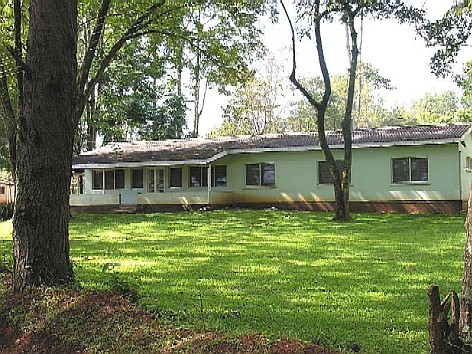
Our old house in Mumias
Then we head for St. Mary’s Mission Hospital in Mumias. For a short while, 30 years ago, I was the resident doctor in charge there and I have good memories of those days. The place has incredibly extended and I have difficulties recognizing the treatment rooms and wards. Although we are unannounced visitors, the deputy matron is very friendly and takes her time showing us around. Since Herfkens, one of our former ministers of development co-operation, in her unfathomable wisdom, made it impossible for young doctors to work some years in Africa, there have been no Memisa (Cordaid) doctors in Mumias. We are, therefore, pleasantly surprised to find two Dutch final year medical students (UvA and RUL) who spent an internship in St. Mary’s. A little later we also meet two young Dutch nurses in training (Fontys). Apparently the Dutch universities and professional training institutes have found ways and means to minimise the negative effects of misguided political follies! Later, when we sit in the dark on the front porch of our room, Paul ponders again on the capabilities and abilities of Dutch politicians in general and the ministers of development co-operation in particular. Herfkens, a career diplomat from the World Trade Organization, was certainly not stupid but lacked profound insight in the day to day problems of development. At the same time, she apparently did not believe in creating awareness in the Netherlands with respect to the development issues. Young white experts in developing countries, whether doctors or not, not only contribute to the development of rural areas, where local experts often do not want to work, but also create awareness in their home countries.
Awareness with respect to one of the greatest challenges of the 21st century: the eradication of mass poverty! Our present minister of development co-operation, is doubtlessly a person of high integrity. But she would neither qualify as a manager of a large development project, nor as a simple university lecturer in development. However, let us not talk politics any longer. After St. Mary’s, we visit the home of the cook of the Mumias Club, somewhere in the rolling hills outside Mumias, and eat lunch prepared by his mother. Later in the afternoon, Paul has the car washed and prepares her for our trip north to Kaibichbich, Marich Pass, Lodwar and Lake Turkana.
Tuesday 03-10 (230 km)
At 09.00 hours we are on the road to Kakamega where we want to visit Julius Makatiani, Paul’s former Kenyan counterpart. We find his house without problems and it is great to see him and his wife back in good health after so many years! We exchange family news for an hour or so and promise to keep in contact. Then we head to Kapenguria, Makutano and Kaibichbich. Shortly after Makutano, we leave the tarmac and turn on a steep murram mountain road. Paul misjudges the steepness and rockiness of the first slope and half way the engine stalls. Only after we have all vacated the car, does Paul manage to get her on top of the hill. In second low gear we begin to conquer the next 24 km. The road is dreadful and now and then almost washed away. Slowly we climb up to 2700 metres and Paul frequently has to shift to first gear. Wa Bashasha’s engine is roaring, the gears are whining and, not withstanding the cold, Paul is sweating and swearing. Shortly before dark, we reach the mission station at Kaibichbich, where we meet father Mulumba and Sister Rita Maria, the sister of Huub Manderveld.
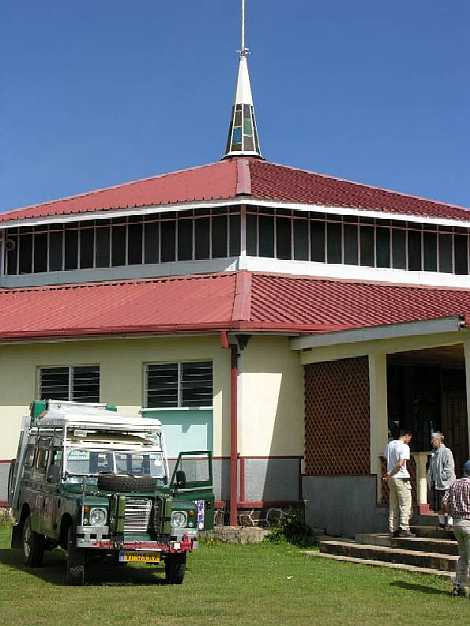
The mission church in Kaibichbich
With the exception of Eelko, who sleeps in an outhouse, we all are allocated beds in the father’s house. Later that night we have dinner with father Mulumba and Sister Rita Maria and chat. When we go to bed, it is bitterly cold.
Wednesday 04-10 (40 km)
I wake up at 08.00 hours and realise that we were allocated separate rooms. Apparently the single rooms the Italian fathers slept in when they ran the mission station until two years ago. I wash in the wash basin with cold water, and cold it is at almost 3000 m, dress and then look for Paul. He is sitting on the small veranda and watches the magnificent High Cheranganis Mountains. After breakfast, father Mulumba wants us to visit some of his outstations and all of us squeeze into Wa Bashasha: Paul and the Father in front, Meta, Eelko, Huub, Rita Maria and a Highland Pokot preacher in the rear. Over a mountain track it goes up again and soon we are well over 3000 m high. Paul, fearing for Wa Bashasha’s wellbeing, is far from pleased. Until after midday, however, we continue our tour. First visiting the home of the preacher (a tidy small Lowland Pokot homestead, where we are welcomed as old friends), then an outstation church, a secondary and primary school and a sheep shearing station. The area is extremely isolated, but the people look well fed and well clothed and are all very friendly.
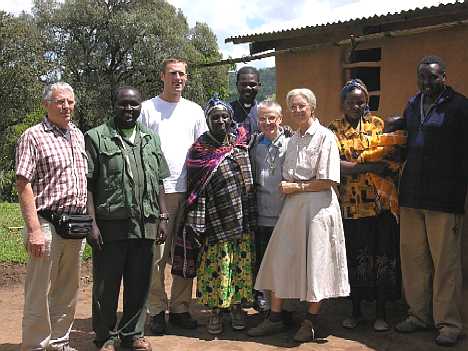
The entire party somewhere near Kaibichbich
Paul is relieved when he steers Wa Bashasha into the mission courtyard again and finds her still in one piece. We chat with father Mulumba and Sister Rita Maria, have a tasty dinner and turn in early.
Thursday 05-10 (0 km)
Planning to leave for Marich Pass, which is only 100 km north of Kaibichbich, we agree to visit an other secondary girls school and a polytechnic. It is an interesting experience, but by the time we have visited all classes, it is too late to leave Kaibichbich. We spent a leisurely afternoon discussing development in Africa. After an early dinner we attend mass in the girls secondary school. It is a very lively ceremony and we are astonished at father Mulumba’s oratory and acting capabilities. If a professional Dutch camera crew had been present, the resulting film could have raised thousands of Euros for the mission!! Something for the Manderveld’s to think about.
Friday 06-10 (100 km)
It is still cold when we leave Kaibichbich in the morning and descend along the Cherangani “Highway”. It takes us just over an hour to cover the 24 km of dirt road to the tarmac at Makutano. Since we are descending from an altitude of almost 3000 to 1600 m and since the rains have washed away parts of the murram road, Paul has to keep Wa Bashasha in low gear all the time. When we arrive in Makutano, we have only some 5 litres of petrol left. Luckily there is a petrol station where we can fill up three of our four tanks and a small shop where we can buy water, bread, some cans of Tusker and some sodas. At 11.30 we are ready for the road towards Lodwar, Lake Turkana and the Ethiopian border. When we descend from the High Cheranganis, the landscape and the climate changes dramatically. The green hills vanish and are replaced by rocky, almost barren hills. The temperature rises from some 10 Centigrade to well over 30. The tarmac road disintegrates into a rocky track. Just beyond the Marich Pass we are overtaken by a pickup with 2 armed soldiers in the back. Ten minutes later, the spikes on the road are those of a military road block. We are apparently leaving secure Kenya and entering the realm of the warring cattle herdsmen. The soldier on duty asks us where we are going and when we tell him we are heading towards the Marich Pass Field Study Centre, we are waved through. At night we light an oil lamp and sit in front of our round hut in the Field Study Centre. Because of the skirmishes in this north-western part of Kenya, individual civilian travel is banned beyond Lodwar. The same, we learn, is the case in the north-eastern part. Wa Bashasha is too slow to join a military convoy to the north and, after due consideration, Paul, long last and finally, decides not to hire an armed escort to get us into Ethiopia. So, exactly 17.023 km after we left Cape Town, our great “trek” north through Africa has come to its untimely end. We discuss the alternatives and decide to drive back to Dar es Salaam in Tanzania in order to try and ship the car to Jeddah in Saudi Arabia. From there, we can then drive to Jordan and reach Turkey via Syria. Failing that, we will drive Wa Bashasha all the way back to Cape Town and then ship her to Lisbon. From thereon, presumably, it will be a piece of cake.
Saturday 07-10 (50 km)
The Marich Pass Field Study Centre is a surprising place. Situated on the banks of the Maruni river, it features a well equipped camping site and a large number of bandas, ranging from basic to en-suite. There is a dining room and plenty of place to sit outside and admire the settings. In the afternoon, we hire a Pokot guide and visit a local Pokot market some 25 km from the Field Study Centre in Lomut.
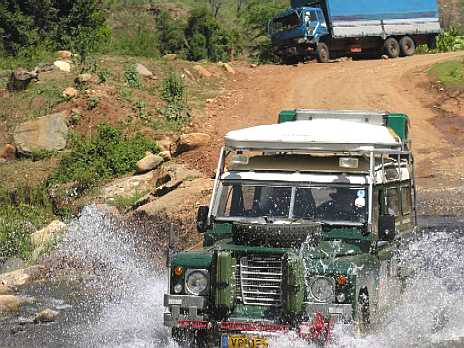
Wa Bashasha crossing a river in Pokot territory
Again, Wa Bashasha has to deal with rough roads and to cross a rocky river twice. The market is crowded and we enjoy walking around for an hour before returning. In the shade of the trees at the Field Centre, we evaluate the place. Everything is simple, clean and well maintained. All sanitary provisions work as designed to. In short, we find ourselves at the best midrange place we have visited so far. Not only in Kenya, but also in the other African countries we passed through. The owner, an Englishman, is on safari. Luckily, however, we have the privilege to speak to his Eritrean wife. On your way to the west side of Lake Turkana, don’t forget to spend at least one night at the Marich Pass Field Study Centre. You are unlikely to ever forget the place. We hope the owners will hang on for many years to come!
Sunday 08-10 (125 km)
From Marich Pass to Mount Elgon is only 125 km and we arrive there – Delta Crescent Camp and Safaris – early in the afternoon. In view of the onset of the short rains, we hire two bandas, have an early dinner and spend the evening talking around the blazing log fire.
Monday 09-10 (0 km)
At 08.30 we all climb in a 25 year old Toyota Landcruiser and head for the Chorlim Gate of the Mount Elgon National Park. At the gate, we pay our entry fees and pick up a ranger with a FN riffle and 20 rounds of ammunition. Then we head for the Saïto dam at an altitude of some 2600 metres. On the elephant platform, we have a packed lunch and then proceed to the caves where the elephants come at night to lick salt. Ten minutes later, the Cruiser has a flat front tyre and we get stuck in the red mud. Digging it out requires the better part of one and a half hours.
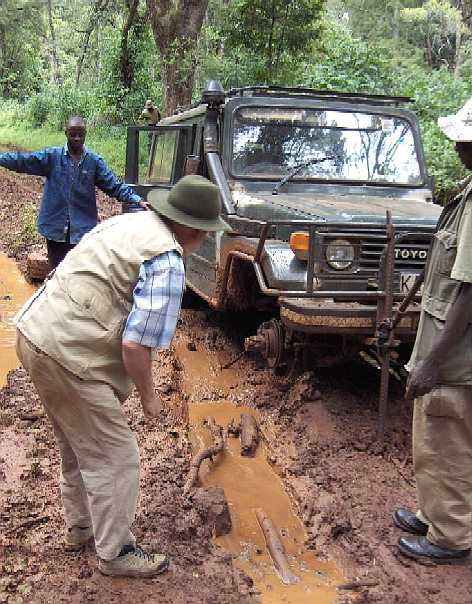
This would never have happened with a Land Rover Series III
The Kitum Cave, with its bats and a skeleton of an unlucky elephant that ventured too far into the cave, is particularly interesting. It is almost 16.00 hours, before we are back at the gate again. We drop our ranger and proceed to the Mount Elgon Lodge where we have a beer before returning to the Delta Crescent Camp. The Mount Elgon Lodge, turns out to be the former colonial residence of the Powles family. Although the house is badly run down, its former grandeur still shows! The Delta Crescent Camp is secluded and green and a good place to camp. The bandas are clean and sufficiently furnished. The toilets and showers, however, are filthy. As so often, with the exception of South Africa, Namibia and Botswana, we find campsite sanitary provisions in Africa totally inadequate.
Tuesday 10-10 (235 km)
From Mount Elgon to the Kembu Campsite in Njoro almost takes us 7 hours. Secondary and even tertiary roads in Kenya (white and yellow on our maps) are often in a reasonable state. Potholed, yes, but passable by car. In contrast, many of the main roads, linking important economic centres, are in a abominable state. Deep potholes every few metres are rule rather than exception and sometimes the entire tarmac surface has disappeared. Repairs are either not done at all, or done in a totally inadequate manner by filling potholes with murram or boulders. So far, we have driven 18.000 km through Africa and the Kenyan major roads are the worst we have encountered by far. Some 30 years ago, Kenya had among the best roads in Central, Eastern and Southern Africa. Even some 16 years ago, when we drove from Nairobi to Mumias and back, the roads were still in good condition. Now, they are a shame to the responsible politicians! Kembu campsite has not changed since three weeks ago. We decide not to rent the caravan, but to camp instead. Just before dark, the overland trucks arrive again and soon the campsite is crowded with the tents of their passengers. Luckily we are in a far corner! We buy vegetables and beef at the bar, make a stew and have dinner. The wind is getting colder and colder and eventually we flee to the bar to have an expensive glass of very mediocre wine. Kembu Campsite – owned by the old settler Nightingale family – has clearly two faces. Their cottage accommodation is of high quality, the food served in the cottage is excellent and the breakfast is exactly what you would expect in what once used to be the “white highlands”. The serving staff is exemplary. All this is not really cheap, but definitely very good value for your money. The campsite is nothing out of the ordinary. There is some green grass, too few cooking places for individual travellers and too few, if any, dish washing places with hot water. The drop toilets and showers are moderately clean to downright filthy, depending on the time of the day and the number of overlanders with upset stomachs. The friendly and social dogs of the Nightingale’s are the real asset of the campsite and tend to soften your judgement after a couple of days.
Wednesday 11-10 (220 km)
Early in the morning Paul checks the still leaking left front wheel hub with George Theuri, the Land Rover Series III specialist of Roving Rovers. The integrated seal is leaking. The inside of the hub is degreased thoroughly and 3 mm of silicon is applied. After 30 minutes it is hard enough. A short trial run shows that the hub is not leaking anymore. We set off to Wajee Nature Camp near Nyeri. We arrive in Nyeri at 15.00 hours, but then have great problems finding the bloody camp. After some 30 km of badly corrugated dirt road we finally arrive at the gate. After some deliberations, we rent two rooms in the Wajee Cottage. A small run down cottage built in 1941, but with a dining room and a bathroom/toilet. All very shabby and basic, but reasonably clean. The friendly camp staff cooks a meal for us and later that night we sit around an enormous open log fire to keep warm.
Thursday 12-10 ( 0 km)
Early in the morning it starts raining and Paul is worried that it heralds the onset of the short rains. If the latter is the case, it will limit our possibilities to camp. Whilst Paul works on our travel log entries, the Manderveld family and I walk the forest in search of a famous and almost extinct babbler. Although we neither sight nor hear the bird, the walk is pleasant and we are back in time for lunch. We have an idle afternoon. Dinner consists of macaroni and an incredibly though beef stew. There is a strong cold wind and we glad that the aged camp guard lights a huge log fire again. To our surprise the old man speaks excellent English and for over two hours we talk about the (Kikuyu) life in the highlands of Central Kenya. Peasant farmers with one or two acres, growing maize and beans for their own consumption and coffee and/or tea for some cash income. Most of them live under the poverty line and youth unemployment is staggeringly high. After more than 30 years of Arap Moi, faith in politics has evaporated, although some speak favourably about the new president, Kibaki.
Friday 13-10 (120 km)
At night there is the first heavy rain and in the morning we plough trough the thick red clay back to main road. Then we are on Kenya’s ruined main roads again and creep towards Thika. We arrive there early in the afternoon and after some confusion manage to get two double rooms in the Blue Posts Hotel, adjacent to the Thika Falls. We have a pleasant dinner and turn in early.
Saturday 14-10 (32 km)
At lunch we meet five people from the St. Paul’s choir in Nairobi. Paul en Eelko tried, so far in vain, to get CDs pressed for these people. It is explained why, very regrettably, the CD project met so many delays and new commitments are made. The lunch is very pleasant and the talks very interesting. I particularly remember the joke made by one of these Kenyans about the country’s roads. “Why our roads have disappeared?” “They have not disappeared but are holiday most of the time!” “Like our politicians and our rich”. “All of them own huge 4x4 vehicles which do even more damage to the roads which are already terribly bad”. “Purposefully they obstruct any programmes for road improvement, because they want all to be given helicopters in their next term in office!”. At night we meet some friends of Eelko and have a cosy dinner in a grill restaurant in Thika. Paul has to drive Wa Bashasha back to the hotel after three half litre bottles of beer, but manages to get her safely in the courtyard. In the dark we pack to car for to morrow. After dropping off Eelko’s father at the Nairobi International airport in the early morning we will then continue our voyage back to Arusha in Tanzania.
© 2005-2006 Paul and Meta Lapperre - Website by MvS
